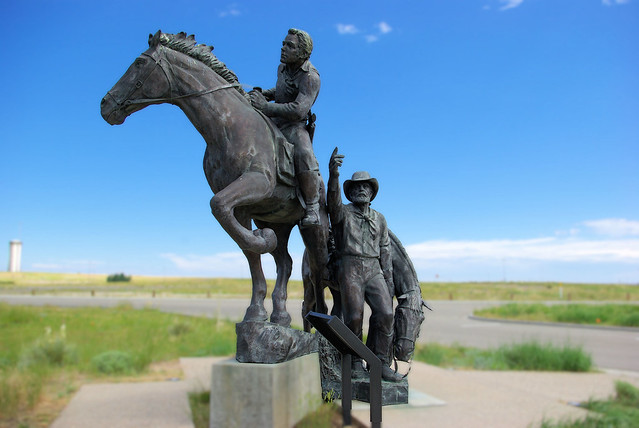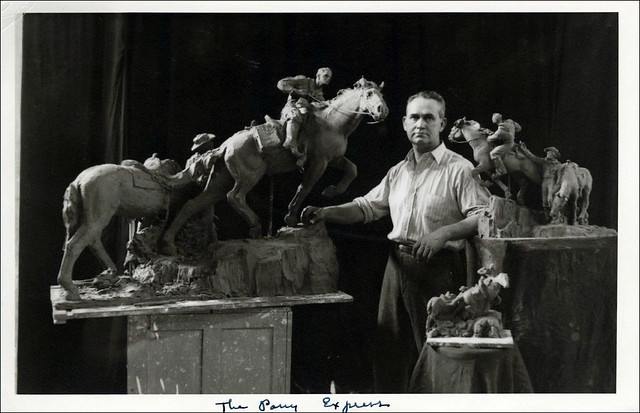
“The Pony Express” sculpture by Dr. Arvard T. Fairbanks at the
National Historic Trails Interpretive Center, Casper Wyoming; July 11, 2010.
On July 11, 2010,after leaving Douglas, Wyoming, we headed to our next campground at Pathfinder Reservoir, west of Casper, Wyoming. One of the places we visited along the way was the National Historic Trails Interpretive Center. Outside the center, a two-times-life-size bronze sculpture greets visitors.
“The Pony Express” originated as a life-sized parade float monument to the Express, constructed of white plaster over a wire and wood framework . The float was used in the Pioneer Day Parade and other Utah parades in 1947, the Centennial year of the Utah Pioneers. Through use and age, the temporary sculpture deteriorated and was placed into storage. The sculpture was replicated in bronze from the original as well as Fairbanks’ preliminary models by Robert Shure and Arvard Fairbanks’ sons, with one copy going to the Pioneer Trail State Park in Salt Lake City Utah and a second copy to the National Historic Trails Interpretive Center, donated to the people of the United States for their perpetual enjoyment.
The statue depicts a young rider just having mounted a fresh horse and not yet fully settled into the saddle. Behind him and to the side stands an older man, possibly a Pony Express station keeper, holding the reins of a spent horse, his other hand raised in salute to the youngster just setting out.

Avard Fairbanks, in his studio with preliminary models of his Pony Express sculpture, circa 1947.
Pony Express Trail (National Historic Trails Interpretive Center)
For eighteen months starting in April, 1860, the Pony Express was the talk of the nation. Since that time it has become a legend the world enjoys. The firm of Russell, Majors and Waddell turned the idea into reality and a crew of “young, skinny, wiry fellows…expert riders willing to risk death daily” carried it out. Each rode over 100 miles a day, changing horses every 10-15 miles. They carried the mail between St. Joseph and Sacramento, 2,000 miles in ten days, sometimes less. The completion of the transcontinental telegraph in October, 1861 signaled the end of the Pony Express.
The Pony Express Trail follows the Oregon and California trail routes through eastern Wyoming and South Pass to Fort Bridger. From there it makes use of the Mormon Pioneer Trail into the Salt Lake valley. The route is well marked, both along the actual trail and on parallel highways and byways. Much of the trail is on BLM public lands west of Casper.

